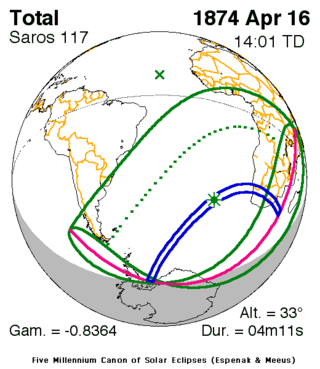
Back Сонечнае зацьменне 16 красавіка 1874 года Byelorussian خورشیدگرفتگی ۱۶ آوریل ۱۸۷۴ Persian Eclissi solare del 16 aprile 1874 Italian 1874년 4월 16일 일식 Korean 1874年4月16日日食 Chinese
| Solar eclipse of April 16, 1874 | |
|---|---|
| Type of eclipse | |
| Nature | Total |
| Gamma | −0.8364 |
| Magnitude | 1.0569 |
| Maximum eclipse | |
| Duration | 251 s (4 min 11 s) |
| Coordinates | 39°54′S 0°54′W / 39.9°S 0.9°W |
| Max. width of band | 335 km (208 mi) |
| Times (UTC) | |
| Greatest eclipse | 14:00:53 |
| References | |
| Saros | 117 (61 of 71) |
| Catalog # (SE5000) | 9220 |
A total solar eclipse occurred at the Moon's ascending node of orbit on Thursday, April 16, 1874, with a magnitude of 1.0569. A solar eclipse occurs when the Moon passes between Earth and the Sun, thereby totally or partly obscuring the image of the Sun for a viewer on Earth. A total solar eclipse occurs when the Moon's apparent diameter is larger than the Sun's, blocking all direct sunlight, turning day into darkness. Totality occurs in a narrow path across Earth's surface, with the partial solar eclipse visible over a surrounding region thousands of kilometres wide. Occurring only about 16 hours after perigee (on April 15, 1874, at 22:45 UTC), the Moon's apparent diameter was larger.[1]
The path of totality was visible from parts of modern-day southern Namibia, South Africa, and Lesotho. A partial solar eclipse was also visible for parts of southern South America, Antarctica, Southern Africa, and Central Africa.
- ^ "Moon Distances for London, United Kingdom, England". timeanddate. Retrieved 2 September 2024.
